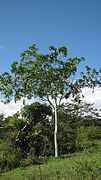Genipa americana
Genipa americana (/ˈdʒɛnɪpə/) is a species of trees in the family Rubiaceae. It is native to the tropical forests of North and South America, as well as the Caribbean.
| Genipa americana | |
|---|---|
 | |
| Flower | |
| Scientific classification | |
| Kingdom: | Plantae |
| Clade: | Tracheophytes |
| Clade: | Angiosperms |
| Clade: | Eudicots |
| Clade: | Asterids |
| Order: | Gentianales |
| Family: | Rubiaceae |
| Genus: | Genipa |
| Species: | G. americana |
| Binomial name | |
| Genipa americana | |
| Synonyms | |
|
List
| |
Description
Genipa americana trees are up to 30 m tall and up to 60 cm dbh.[1][2][3] Their bark is smooth with little fissures.[3] The leaves are opposite, obovate, or obovate oblong, 10–35 cm long, 6–13 cm wide, and glossy dark green, with entire margin, acute or acuminate apex, and attenuated base.[1][4][2] The inflorescences are cymes up to 10 cm long.[1] The flowers are white to yellowish, slightly fragrant, calyx bell-shaped, corolla at 2–4.5 cm long, trumpet-shaped, and five- or six-lobed.[1][4][2] The five short stamens are inserted on top of the corolla tube.[4] The fruit is a thick-skinned edible greyish berry 10–12 cm long, 5–9 cm in diameter.[1][4]
Distribution and habitat
Genipa americana is native to the tropical forests of the Americas, from tropical Florida south to Argentina.[1][5][6] It is present from sea level up to 1200 m of elevation,[3] although some argue the original native range as being northern South America.[7]
Vernacular names
In English, the tree is known as the genip tree /ˈdʒɛnɪp/ and the fruit as genipap /ˈdʒɛnɪpæp/.[8]
Colombia: jagua, caruto, huito;[3][5] Brazil: jenipapo, formerly genipapo;[3] Costa Rica: guaitil, tapaculo;[3] Nicaragua: tapaculo, yigualtí;[3] Mexico: shagua, xagua;[3] Perú: huito, vito;[5] Argentina: ñandipá;[5] Bolivia: bí[9]
Chemical compounds
The following compounds have been isolated from G. americana: genipic acid,[11] genipinic acid,[11] genipin[12] (all three from the fruit) and geniposidic acid (leaves).[11]
Uses
The unripe fruit of G. americana yields a liquid used as a dye for tattoos, skin painting and insect repellent.[6]
This species is also cultivated for its edible fruits, which are eaten in preserves or made into drinks, jelly, or ice cream.[6]
The wood is reported to be resistant, strong, and easily worked; it is used in the making of utensils and in construction and carpentry.[2][3]
Gallery
 Tree
Tree.jpg) Leaves and fruits
Leaves and fruits
See also
References
- Liogier, Alain H. (1985). Descriptive Flora of Puerto Rico and Adjacent Islands. La Editorial, UPR. p. 97. ISBN 9780847723386.
- Francis, Macbride, J.; E., Dahlgren, B. (1936). "Flora of Peru /". Fieldiana. v.13:pt.6:no.1 [Rubiaceae]: 106.
- López, René; Montero, Martín (2005). "27 - Genipa americana". Manual de identificación de especies forestales con manejo certificable por comunidades (in Spanish). Instituto Amazónico de Investigaciones Científicas "SINCHI". ISBN 9789589759745.
- Food and Fruit-bearing Forest Species: Examples from Latin America. FAO. 1986. pp. 141. ISBN 9789251023723.
- Grandtner, M. M.; Chevrette, Julien (2013). Dictionary of Trees, Volume 2: South America: Nomenclature, Taxonomy and Ecology. Academic Press. p. 263. ISBN 9780123969545.
- Hanelt, Peter; Research, Institute of Plant Genetics and Crop Plant (2001). Mansfeld's Encyclopedia of Agricultural and Horticultural Crops: (Except Ornamentals). Springer Science & Business Media. p. 1775. ISBN 9783540410171.
- Duarte, Odilo; Paull, Robert (2015). Exotic Fruits and Nuts of the New World. CABI. pp. 284–285. ISBN 9781780645056.
- "genip, genipap". Oxford English Dictionary (3rd ed.). Oxford University Press. September 2005. (Subscription or UK public library membership required.)
- Coimbra Sanz, Germán (2014). Diccionario enciclopédico cruceño, 3rd edition. Santa Cruz de la Sierra: Gobierno Autónomo Municipal de Santa Cruz. p. 54.
- Chacon, Thiago (2013). On Proto-Languages and Archaeological Cultures: pre-history and material culture in the Tukanoan Family. In Revista Brasileira de Linguística Antropológica. Vol. 5, No. 1, pp. 217-245.
- Connolly, J.D.; Hill, R.A. (1991). Dictionary of Terpenoids. 1. CRC Press. pp. 49–50. ISBN 9780412257704.
- Bajaj, Y. P. S. (2012). Medicinal and Aromatic Plants IV. Springer Science & Business Media. p. 164. ISBN 9783642770043.